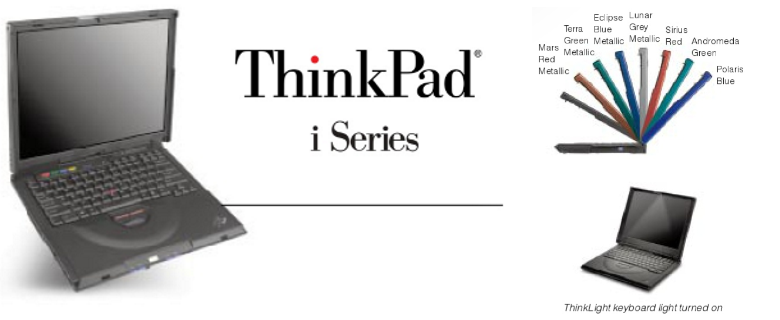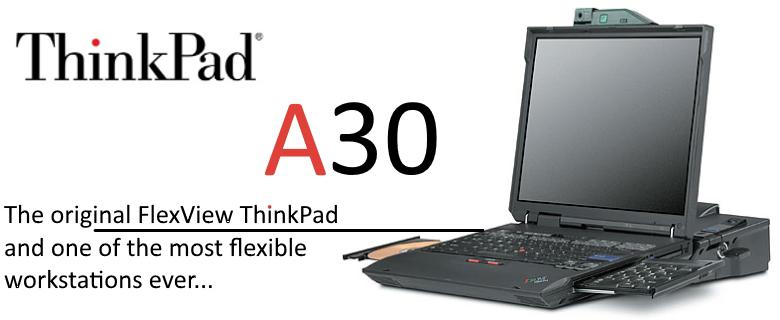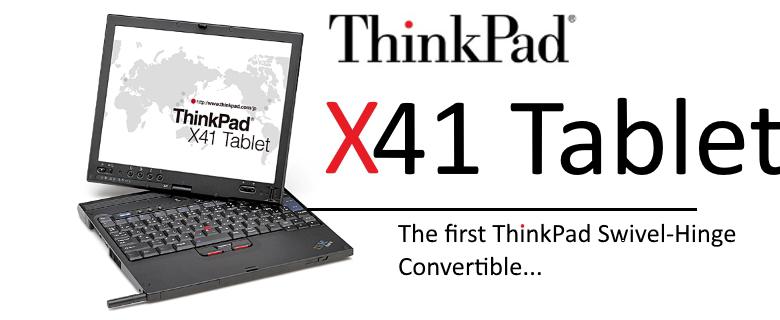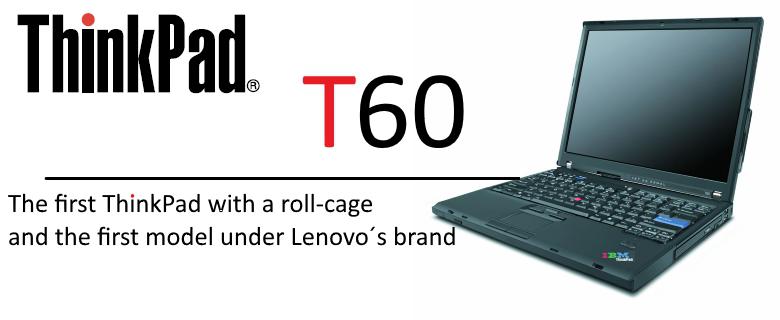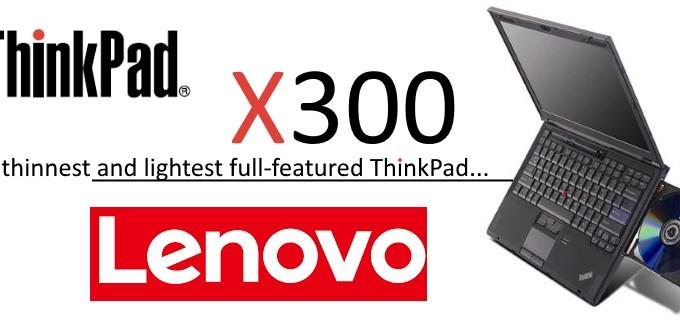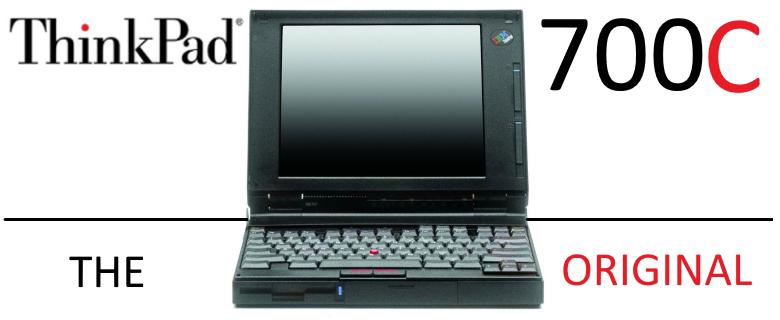This post marks a start of a new mini-series of posts written by me “Top 10”. In these posts, I will rank the top 10 ThinkPads in a certain category. This time, I want to name the most influential ThinkPads until now, the ThinkPads that helped the brand grow the most. So its not about the most innovative models, which means that you won´t find Butterfly or W700ds here, but about the most important models, which had innovations that spread within the lineup and changed ThinkPads forever.
Note that this is purely based on my opinion and my thoughts.
10. IBM ThinkPad i-Series 1400
The 10th position on this list is taken by the ThinkPad i-Series 1400. The i-Series 1400, produced from 1998 to 2000, was part of IBMs first attempt to make ThinkPads more affordable and also target a slightly different customer-base. All i-Series had multi-colored audio-buttons, called the EasyLaunch buttons, some featured media keys and big speakers beneath the screens, and they were available with lid in different colors. To make them cheaper they omitted the traditional Ultrabay, had smaller displays in some models(like 13” displays in a 14” chassis), and of course, they were made by (back then) long time IBM partner Acer. You could say they started a tradition that later spawned the R-, SL- and Edge / E-Series ThinkPads. Cheaper ThinkPads, only with the most necessary features, and a fresher design.
Now, thats of course not the reason why the 1400 is found on this list. No, the real reason is that this is the first model with a ThinkLight. At the time, laptops didn´t have backlit keyboards, and the 1400 was one of the first machines that had a keyboard illumination. It was one of the little details, that make ThinkPads so much more useful than many other machines, and the i-Series 1400 spawned a tradition, that lasted in form of the ThinkLight until the T430 generation and was one of the ThinkPad defining traits. And, you could argue, is still in place with todays backlit models . Yes, its not the same, and yes, of course, Apple did it first - but both of these features are just different methods to accomplish the same thing: Illuminate the keyboard, and make working in dark environments easier.
The i-Series 1400, the first ThinkPad with a ThinkLight and the first ThinkPad with an illuminated keyboard!
9. IBM ThinkPad A30
The A-Series, long discontinued, once was IBMs top-end workstation class ThinkPad series. Even today, A31 units are still being used in the International Space Station, alongside T61 units. That alone tells you a lot about how dependable and durable these machines were.
As a top-end workstation model, the A30 was a highly innovative and powerful platform on its own. Not only was it the first ThinkPad with Bluetooth build in, a standard feature since then, its also the first ThinkPad with a unique dual-UltraBay architecture, which allowed you to have HDDs in the system at the same time (2x in the Ultrabays, 1x in the normal HDD bay), or two HDDs and one extra battery, or two extra battery and one HDD, and so on, you get the point: It was an extremely flexible system. Unfortunately, the A30, alongside the A31, was the only system with this unique ability. The real innovation of the A30, that influenced generations of ThinkPads, up until today: The legendary FlexView IPS technology, that first debuted here in the form of an (back then) extremely expensive UXGA 1600x1200 screen. Screen quality this good was unheard of at the time, and these screens, made by IBMs own IDTech, would still hold today, if it weren´t for their CCFL technology, which isn´t as long lasting as todays LED screens.
The A30 was released in 2001 and discontinued in 2003. It was followed by the A31, the Pentium 4 refresh based on the A30. The A-Series was discontinued after the A31. The position as the workstation line would later be assumed by the R50p, then the T6xp line, and finally todays W-Series.
The FlexView technology on the other hand was continued in the R50p (with an amazing QXGA FlexView screen), T4xp line and finally the T60p. Due to the switch to widescreen, FlexView died for a few years on workstation models, being only available on X-Series tablets. But finally, after nearly 7 years of absence, FlexView IPS technology returned with the T440s/W540 generation. If you get a ThinkPad, be sure it has an IPS screen!
8. IBM ThinkPad 570
Another classic IBM machine, another category-defining machine. The classic no-compromise subnotebook.
In the 90s, IBM had quite a different model lineup and naming convention than in the 2000s. T-, X- and A-Series did exist, yet. Instead IBM used a purely number based naming system. The smallest and most low-end systems were the 200 and 300 series systems. The 500 series was the mid-range series. Above them sat both the 600 series, which really was the premium Ultraportable line, and of course the 700 series, the high end workstation series, and the original ThinkPad series. To make things slightly more complicated, add the POWER-PC based 800 series (which wasn´t the biggest success apparently) and the low-end i-Series (which I already mentioned in the #10 spot).
All that changed in May of 2000, with the introduction of the T and A series ThinkPads, T20 and A20m / A20p. The X series followed in September 2000 with the X20. Its predecessor was the ThinkPad 570. Whats so special about the 570 you might ask? Well, talk about the UltraBase! Thats right, the 570 was the first model with an UltraBase. The UltraBase was (as it was discontinued after the X230) a great accessory - a dock, which was actually mobile - it made the machines a little bit thicker, but added tons of ports, sometimes speakers, and always an UltraBay. 570, like any subnotebook, didn´t have an ODD (which of course, was hugely important back in the day), so the UltraBase transformed it into a fully-functional Notebook.
The 570 was on sale from 1999 to early 2001, when it was replaced by the mentioned ThinkPad X20. So in a way, this is the great-grandfather of #6^^
7. Lenovo/IBM ThinkPad Z60t
When Lenovo took over the IBM PC devision in 2005, the ThinkPad lineup solely based on 4:3 displays. 3 years later, every ThinkPad adopted widescreen 16:10. Whether you prefer widescreen or 4:3, its undeniable that the newly established Z-series played a big part in the rise of the widescreen for ThinkPads.
The first of the two Z-series models, the Z60, was released in September 2005, as the second model after the successful acquisition by Lenovo (the first one is also on this list… :-) ). Although the “60” model number implies different, it was still based on Intels last single-core platform for Notebooks, the Intel Pentium M, that also powered the T4x and R5x models. Despite its old platform, the Z60 series had a completely new chassis, with roll-cage and new editions of the ThinkPad keyboard, UltraNav, UltraBay, docks, etc. . But thats not the main differentiator of the Z60 series. Oh no. That was the fact that it was the first 16:10 widescreen ThinkPad ever released. Although people like to claim that Lenovo was the one who started “widescreen mania” with this, it was actually IBM, as the development of this model started well before the acquisition. Even IBM couldn´t defer the market, sad but true. With its success, widescreen displays were slowly introduced in other ThinkPad lines, first in the T-, then in the R- and X- series, which is kind of ironic, as this success after all made the Z-series obsolete and killed it, after its Core 2 Duo update Z61. When the T500/T400/R400/X200 were released, the Z-series just was unnecessary.
The reason why I picked the Z60t over its bigger siblings is, because it not only did introduce widescreen, but also beyond that introduced a new method for the use of Carbon fiber in the display assembly - as you may know, Carbon fiber is now being used in many high-end ThinkPad systems, so that was an important step in ThinkPad chassis development.
6. Lenovo/IBM ThinkPad X41 Tablet
Although I wrote “Lenovo/IBM ThinkPad” here, since the development was well underway before the Lenovo takeover, the X41 Tablet is in fact the first ThinkPad ever released by Lenovo. And not only that. This Pentium M subnote is also the first ThinkPad X-Series Tablet, which was the dominating sub-line of ThinkPad convertibles until 2013.
Released in June 2005, so nearly exactly 10 years ago, the X41t was the first Pen ThinkPad. Or was it? Of course not. The very first machine that had the ThinkPad name, the ThinkPad 700t, originally named IBM 2521 ThinkPad, was a Pen-Tablet. But the X41t was the start of the “modern” ThinkPad convertible. It was released as a part of Microsofts Windows XP TabletPC Edition lineup, and thus was sold with this XP SKU (which was not sold in retail, so it was only available if you bought a machine like the X41 Tablet that had it preinstalled). So its pretty obvious why the X41t made it on this list: It was the first ThinkPad with the swivel hinge, that defined ThinkPad convertibles and also convertibles in general until the rise of the “Yoga” 360° hinge form-factor.
The X41 Tablet was replaced by the X60 Tablet in November 2006.
5. Lenovo ThinkPad X1 (2011)
When ThinkPads were under the IBM brand, there were some ThinkPad characteristics that were unchangeable. One of these characteristics was the keyboard, that, despite small modifications here and there, always was essentially the same from 1992 to 2011. All of that changed with the ThinkPad X1. Some would call this move blasphemy. I call it bold, to have the courage to change something so essential like this.
The X1, the original, was released in 2011, as the new 13” flagship type model and the spiritual successor of the X300 line. However, with this project, Lenovo did have different goals compared with the X300. The X1 was supposed to be a top-notch machine with all the trademark ThinkPad qualities and design, but also as a machine that blurs the line between business and consumer and a highly innovative machine. And thats indeed what it was. With its boxy and aggressive tampered design, it was immediately identifiable as a ThinkPad. When you picked up the X1, you quickly noticed the high quality materials and construction, with a thick Magnesium frame. The red, familiar TrackPoint that welcomes any long-time ThinkPad user. Beyond these classic attributes, you have the Gorrilla Glass covered glossy HD high-nit screen, the new ClickPad without TouchPad buttons (the first time ever on a ThinkPad), an integrated Lithium-Polymer battery with RapidCharge, and, last but not least, the new 6 row ThinkPad Precision backlit keyboard, Chiclet type. This machine is literally “the next gen machine” that defined many trends, like the RapidCharge, or, of course, the new keyboard, which was brought to all ThinkPads in 2012, that still impact todays ThinkPads.
Despite these trend-setting attributes, the X1 wasn´t a huge success. In fact, it was more of a failure for Lenovo. Initially named a Macbook Air competitor, it failed to deliver on that promise. With the surge of the Ultrabooks in 2012, the shortcomings of the pre-Ultrabook X1 became clear fast - its battery was too small, the full-voltage CPU, although powerful, consumed too much, the screen was lackluster, due to the low resolution and the glossy finish, and it also was too thick and too heavy to compete with the new Ultrabook machines. So it was replaced by the original X1 Carbon (2012), which was the first Thinkpad Classic Ultrabook and which adressed many of the X1 shortcomings, resulting in much better sales numbers for Lenovo. But despite the non-success of the X1 itself, the new keyboard was a big success for Lenovo (as it was even called the “best keyboard ever tested” by Laptop Magazine). Which makes the X1 a very influential and important ThinkPad, and thus, places it on this list.
4. IBM ThinkPad 600
The perfect machine. This is the ThinkPad 600.
The ThinkPad 600 was released by IBM in April 1998, two years before the first T-series machine. The 600 was designed to be the best ThinkPad yet. It didn´t have any innovative gimmicky features, like the butterfly keyboard. It wasn´t revolutionary. It was evolutionary. It was one of the first ThinkPads to break with the classic “lunchbox” design, that dominated ThinkPad for much of the 90s. In fact, it looked much like the T20 and later machines. The 600 had the best chassis and the best keyboard at the time, many say that this still holds true even today, 17 years after its release.
So unlike the other machines on this list, it doesn´t have a specific feature that carried over to newer ThinkPads, if you don´t want to count the chassis form factor. The point of the 600 is: Its an ideal. The machine everyone recognized as the best, and the essence of the word “ThinkPad”. The design, the keyboard, the build quality - perfection.
The 600 had two direct successors, the 600e and the 600x, which had the same great chassis and keyboard. As mentioned, it was replaced by the T-Series, which, even today, still is following the great tradition started with the 600 series ThinkPads.
3. Lenovo/IBM ThinkPad T60
Fitting to the 4th place, here is one of the descendants of the 600.
The T60 is the first ThinkPad T-Series released under the Lenovo brand. It was released in January 2006 as part of the new Intel Centrino Napa platform ThinkPad update. As such, it had a number of new features under the hood, that made it stand out compared to the T4x line of ThinkPads - dual-core CPUs, SATA HDDs instead of PATA/IDE (which was really a big thing back then) and 3 GB RAM maximum instead of 2 GB. It also was the first T-Series with UMTS, and with the later models, the first T-Series with 16:10 displays (only 15.4”, 14.1” came with the T61). The T60 also was the last T-Series model with direct involvement of IBM in the development (T61 and T400 were largely based on the T60 design - T400s was the first T-Series without IBMs any involvement at all, T410 the first mainstream model).
So, why is the T60 on this list you might ask? Well, first of, its the last T-Series model with FlexView IPS 4:3 displays - that alone makes the T60 a true classic. More importantly though: The introduction of the Magnesium Structure Frame in the base unit (AKA Roll-Cage). Yes, the T60 wasn´t the first ThinkPad with a roll-cage (that honor goes to the Z60), but it was the first T-Series (which is, after all, the best selling and best known ThinkPad series). For those of you who don´t know, the structure frame / roll-cage is a Magnesium frame in the base of the system. The mainboard in these systems isn´t sitting in the base-unit, its sitting in the roll-cage, which provides ideal protection for the critical components. This innovation was crucial, as the models before the T60, T40-T43, had big problems with flexing, which was partly due to their base-unit design, which didn´t prevent the flexing and twisting that, after longer term use, damaged the system-board and resulted in flexing and system board defects. Although not entirely solved by the roll-cage (since the flexing also had to do with the cooling system and hot components etc.), the structure frame helped big-time resolving this crucial concern and made and makes ThinkPads more reliable, even today - W541, T440p and T540p are based on this design, and models like the T450s, X250 etc. have a even better, more developed structure-frame design (you can read more about this change in my T440s and W550s reviews)- which makes the T60 a crucial landmark for the ThinkPad brand.
The T60 was replaced by the T61 in May 2007 - the T-Series is of course still on the market today in the form of T450s, T450, T440p, T540p and T550.
2. Lenovo ThinkPad X300
Thinkpad X300, codename Kodachi - designed to be a modern 600.
Released in February 2008, the X300 was Lenovos first dedicated flagship ThinkPad. Interestingly enough, it was released very close to the first Apple Macbook Air, which made it, as the thinnest and lightest ThinkPad yet, to a sort of natural competitor to the Macbook Air (which spawned one especially funny commercial). More than that the X300 was the first model of a completely new generation of ThinkPad, and, unknown to many, the first ThinkPad solely designed and developed by Lenovo - all “Lenovo” ThinkPad before the X300 were still based on developments that were begun in the IBM days already. And what a highlight this product was. Lenovo started the developement with a simple, and very difficult, goal: Design a ThinkPad better than IBM could. Whether or not they succeeded with this project is up to your own thoughts.
In this case, there isn´t really a single innovation which I can call out as the most important. The X300 was just so innovative at the time. Technically still a part of the T61 generation, the X300 had many elements of todays ThinkPads already (although not in the design department, of course - when it comes to the outer design, T400s and T431s are more important milestones for change). For the first time ever, a LED screen on a ThinkPad. The thin and light carbon fiber construction, with a new type of roll-cage, that was used for all T4xxs models up until the T430s. The ULV CPUs (as part of Intels non-successful CULV program). In a way, you could say the X300 is the prototype ThinkPad Ultrabook - a thin and light machine, and yet, with little compromise. With the exception of the DVD drive, which recent ThinkPads lost of course, models like the T450s still follow this “non-compromise” idea (which is completely different from Apples “all-compromise” mantra with their new Macbook).
The X300 is a great milestone, and a true ThinkPad. If you want to collect ThinkPads, this is definitely one for the collection (or rather the X301, which is just the same as the X300, but with better CPUs and some neat, modern features like Displayport, for example).
1. IBM ThinkPad 700C
Do I have to write much at this point? Its the original. Thats more than enough!
It was introduced in October 1992 by IBM. With this model, IBM wanted to finally succeed on the difficult Mobile Computing market. The 700C replaced the PS/2 line of notebooks, namely the PS/2 N51, which can be seen as sort of the direct predecessor to the 700C (the N51 also was the first model developed in Japan in the legendary Yamato labs, like the 700C and most other ThinkPads that came out since then).
IBM putted a big bet on this machine to succeed. To make sure it was a success, they did all the right things. They hired Richard Sapper, who was a design consultant for IBM since the late 1980s, to do the design work. He chose a black chassis, instead of the (then) standard gray-beige. At the time, this was unheard of, and truly a revolution, and, even if it seems a bit odd from todays view, it was seen as a bold shift. He also chose the TrackPoint, back then a brand new technology and the first time really brought to the market, to be red, as a stark contrast to the black “bento box” case. With this extraordinary design alone, IBM had a winner already. But of course, ThinkPads also always were about marvelous build quality and an amazing keyboard, and area in which IBM proudly delivered as well. So in these areas, the 700C certainly didn´t fail expectations
What was left to make the machine a big hit was one crucial innovation, that really moves the market forward. And that one came in form of the display, the most important part of the 700C.
As a little background: Back in the early 1990s, Notebooks still had (by todays standard) very small screen, that were more often than not monochrome, with a really lackluster quality. Back when the 700C was developed and when it came to the market initially, 9” was still the standard size for notebook displays. The 700C on the other hand had a 10.4” color (256 color) display, that was unheard of at the time. How did IBM do it? They developed a new display by themselfs, and overcame this big technical challenge. This was the killer feature of the 700C, the display, not the keyboard or the TrackPoint
When the ThinkPad 700C was announced, it made a big impression on both the media and potential customers in enterprise, and the Mobile Computing world was forever changed. Suddenly, everyone wanted a ThinkPad, it kind of even became a status symbol for business people, and IBM was transformed from the industry laughing stock to a leader overnight. The 700C, the Original, started it all. It introduced the ThinkPad brand, and its legendary reputation of being the “Ultimate business tool” and “The gold standard”, and it truly is, and remains, the most influential ThinkPad of them all…
Thanks for taking the time to read this long article! If you enjoyed it, please, comment and share. This is the first one of a series of articles. The next one will be “The top 10 prettiest ThinkPads”…just kidding. It will be “The top 10 Ultramobile ThinkPads”, covering all the best ThinkPads in the “subnotebook” category. Have a great weekend!
